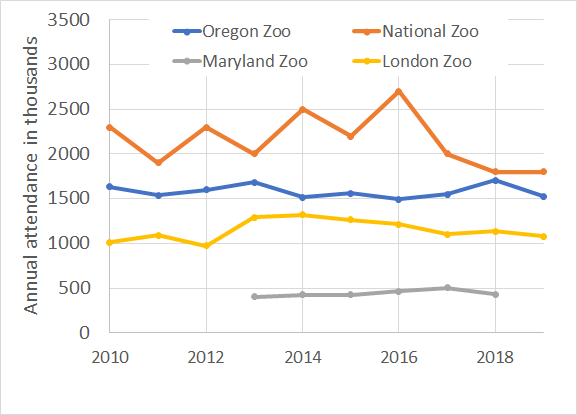Zoos, a product of 19th century attitudes, are out of place in the 21st century and are dying a slow death. Before the age of iPhones and streaming services competing for our attention, they were popular places to look at wild animals captured for our amusement. But technological developments leading to YouTube, Netflix, Virtual Reality and the like bring stunning documentaries to us up close and personal, that show wild animals in their natural settings. And these are now available anywhere, anytime, at no extra cost. In comparison, zoos exhibiting depressed wild animals confined in a poor imitation of their natural habitat is just not attractive to the public any longer.
And it shows.
The graph above shows the attendance figures of various zoos over the last decade, where we see the same pattern — that their attendance has been flat-lining, with minor year-to-year variances, probably due to external factors such as weather, special events, etc. The various zoos were picked based on the availability of attendance figures in the public domain, and the data sources can be found below the bottom of the post.
Now, Oregon Zoo has been claiming that their attendance figures are saturated because of the limited parking availability. This excuse is not at all convincing because the situation that is causing the attendance to flat line is not unique to Oregon Zoo alone, and shared by other unrelated zoos as well. Besides, Oregon Zoo also has the convenience of a MAX station just a few steps from their entrance, which is a real luxury for many zoos.
To make up for this lack of growth in attendance, Oregon Zoo has been trying to increase their revenue by introducing new ways to make money, such as visitors paying extra to feed the animals, or to handle the animals, etc. These are very risky practices, since the visitors are obviously not screened for communicable diseases, and many diseases can transmit between humans and animals. It is quite likely that the Tuberculosis epidemic at the zoo was caused by a human infected with TB transmitting it to the elephants.
So what is the answer to the flat-lining attendance at zoos? It is definitely not to keep digging into the same mode of operation, as Oregon Zoo is doing, by capturing more exotic animals, but to be inventive. The North Carolina Zoo for example is experimenting with a virtual reality exhibit taking us close to wild animals in natural settings. Detroit Zoo realized that elephants do not do well in captivity and took a bold decision 15 years ago, to retire them. A German circus has successfully managed to have “animal acts” using holograms. PETA has demonstrated how conservation education can be shared with the public using animatronics.
There is an opportunity to re-invent zoos as places of conservation education belonging to the 21st century, rather than captivity and entertainment with sad animals. Will Oregon Zoo be bold enough to realize this?
Sources for data:



